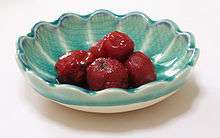Umeboshi

Umeboshi (Japanese: 梅干, pronounced [u͍meboɕi]; literally "dried ume") are pickled ume fruits common in Japan. The word "umeboshi" is often translated into English as "Japanese salt plums," "salt plums" or "pickled plums." Ume (Prunus mume) is a species of fruit-bearing tree in the genus Prunus, which is often called a plum but is actually more closely related to the apricot.[1] Umeboshi are a popular kind of tsukemono (pickles) and are extremely sour and salty. They are usually served as side dishes for rice or eaten on rice balls (often without removing the pit) for breakfast and lunch. They are occasionally served boiled or seasoned for dinner.[2]
Pickled ume which are not dried are called umezuke (梅漬け).
Physical characteristics
Umeboshi are usually round, and vary from smooth to very wrinkled. Usually they taste salty, and are extremely sour due to high citric acid[3] content, but sweeter versions exist, as well. Umeboshi were notorious for their ability to eat their way through the plain drawn aluminum lunch boxes commonly used in the 1960s. The combination of organic acids and salt in the umeboshi were the cause of this phenomenon.[4]
The central area of Wakayama prefecture is known throughout Japan for the number and quality of its ume and umeboshi. The town of Minabe, Wakayama, in particular, grows more ume and produces more umeboshi than any other town in Japan.[4]
Production


Umeboshi are traditionally made by harvesting ume fruit when they ripen around June and packing them in barrels with salt. A weight is placed on top and the fruit gradually exude juices, which accumulate at the bottom of the barrel. This salty, sour liquid is marketed as umezu (梅酢; often translated as "ume vinegar"), although it is not a true vinegar.[5]
Most modern umeboshi are made by using less salt and by pickling the ume in a seasoned liquid or vinegar. They are typically dyed red using purple perilla herbs (called akajiso), or flavoured with katsuobushi, kombu or even sweetened with honey. Because modern methods of preservation use less salt, they usually contain an artificial preservative to extend shelf life.
Consumption
Umeboshi are usually eaten in small quantities with rice, for added flavor. It is also a common ingredient in onigiri, rice balls wrapped in nori, and they may also be used in makizushi. Makizushi made with umeboshi may be made with either pitted umeboshi or umeboshi paste (which is cheaper), often in conjunction with slivered fresh green perilla (shiso) leaves. Umeboshi were esteemed by the samurai to combat battle fatigue. The standard Japanese folk remedy for colds and flus is okayu (rice congee) with umeboshi. Another usage of umeboshi is in "Ume ochazuke," a dish of rice with poured in green tea topped with umeboshi.
Umeboshi is used as a cooking accent to enhance flavor and presentation. They may also be served as a complement of a green tea or a drink with shochu and hot water.
Umeboshi are often eaten as snacks; in the United States, many Japanese grocery stores stock them. Eating umeboshi in Japan is the equivalent of the English expression "an apple a day".[6] Children's candy shops sometimes carry karikari ume, or prepackaged, crunchy pickled ume.
Health
This Japanese style traditional condiment is believed to be a digestive aid, prevention of nausea, and for systemic toxicity, including hangovers. Green ume extract is used as a tonic in Japan. The citric acid is believed to act as an antibacterial, help to increase saliva production and assist in the digestion of rice. Additionally, umeboshi is claimed to combat fatigue (historically given as part of a samurai's field ration) and protect against aging.[7]
Nutrition
Umeboshi per 100 g contains elements as follows.
- Calories 33 kcal
- Protein 0.9 g
- Fat 0.2 g
- Carbohydrate 10.5 g
- Sodium 22.1 mg
- Potassium 440 mg
- Manganese 0.23 mg
- VitaminA 7 μg
- VitaminB1 0.02 mg
- VitaminB2 0.01 mg
- Cholesterol 0 mg
- Dietary fiber 3.6 g
Similar foods
The umeboshi style of pickling is common in Japan and is similar in style to other Asian preserved pickling techniques found in China, Vietnam, and Korea.[8]
In Vietnam, a very similar variety of pickled ume is called xí muội or ô mai.
In South Asian countries, a fruit called amla in Hindi or Amala in Nepali is prepared in the same way, but with Indian gooseberries instead of ume.
In Mexico, it is known as chamoy and is usually made with apricot, ume and or tamarind and a mix of salt and dry chili.
In South Africa, a similar style of preserved dried fruit is called mebos in Afrikaans, the name of which seems to derive from the Japanese via Dutch trade. Usually, apricot is used to produce a salty, acidic variety, although other, sweetened varieties made from other fruits are also colloquially called mebos.
See also
- Li hing mui
- List of pickled foods
- List of plum dishes
- List of sauces
- Pickled fruit
- Suanmeitang
- Wikibooks:Cookbook:Umeboshi
References
- ↑ Tsuji, S. (2007). Japanese Cooking: A Simple Art. Cookery, Food and Drink Series. Kodansha International Limited. p. 317. ISBN 978-4-7700-3049-8.
- ↑ Umeboshi: perfect in any culinary pickle | The Japan Times
- ↑ Nakatafoods: Umeboshi
- 1 2 Itoh, Makiko, "Umeboshi: perfect in any culinary pickle", Japan Times, 25 May 2012, p. 18
- ↑ Mary Choate and Aaron Brachfeld. At Home in Nature, a user's guide. Coastalfields Press. p. 303. GGKEY:K5213DDZJD2. Retrieved 21 January 2013.
- ↑ "Umeboshi: World's Strangest Hangover Cures." Travel and Leisure. Retrieved on March 8, 2009.
- ↑ "HEALTH BENEFITS OF UMEBOSHI : MAKING TRADITIONAL UMEBOSHI : UMEBOSHI - Venerable Pickled Plums : MITOKU COMPANY, LTD. - Organic Japanese Foods Exporter". Mitoku.com. Retrieved 2012-11-19.
- ↑ The 150 healthiest foods on earth. By Johnny Bowden
External links
| Wikimedia Commons has media related to Umeboshi. |